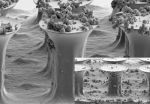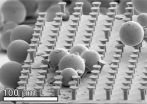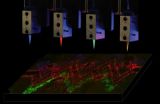(Press-News.org) This news release is available in German.
Geckos outclass adhesive tapes in one respect: Even after repeated contact with dirt and dust do their feet perfectly adhere to smooth surfaces. Researchers of the KIT and the Carnegie Mellon University, Pittsburgh, have now developed the first adhesive tape that does not only adhere to a surface as reliably as the toes of a gecko, but also possesses similar self-cleaning properties. Using such a tape, food packagings or bandages might be opened and closed several times. The results are published in the "Interface" journal of the British Royal Society. DOI: rsif.2013.1205
When moving forwards, the gecko's toes drag across a part of the surface. As a result of this lateral friction contact, larger dirt particles are removed. Smaller particles deposit among the setae on the sole and in the skinfolds below. In an experiment, the researchers have proved that both mechanisms provide for 95% of the self-cleaning effect. "This effect is determined by the ratio between particle size and setae diameter", Dr. Hendrik Hölscher of KIT's Institute of Microstructure Technology (IMT) says.
For their experiments, the scientists used elastic microhairs of variable size. Instead of dirt particles, they employed glass spheres of micrometer size (10-6 meters) and distributed them on a smooth plate. To simulate the steps made by a gecko, they pressed an artificial adhesive tape covered by microhairs onto the plate, shifted it laterally, and lifted the tape off again. This "load-drag-unload" cycle was repeated several times. In parallel, adhesive force was measured.
When the diameter of the spheres exceeded that of the microhairs, the adhesive force disappeared after the first contact ("load") – as in case of an ordinary adhesive tape. After eight to ten test cycles, however, the gecko-inspired adhesive tape reached 80 to 100 percent of its original power again. "In the long term, this effect might be used to develop a low-cost alternative to hook and loop fasteners," Hölscher says. "Such a tape might be applied in the sports sector, in medicine, automotive industry or aerospace technology," Metin Sitti, Professor of the Carnegie Mellon University, adds.
When the size of the spheres was smaller than the diameter of the microhairs, the researchers succeeded in restoring one third of the original adhesive force only. "For the perfect gecko-inspired adhesive tape, we therefore need fibers in the nanometer range (10-9 meters), which are smaller than most dirt particles", Dr. Michael Röhrig, IMT scientist, emphasizes. The skinfolds of the gecko have already been reproduced by wide grooves between narrow rows of hair. They offer enough space for the fine dust to deposit. Tests using real dirt particles of variable shape and size and particles made of various materials are planned to be carried out in the near future.
INFORMATION:
Mengüç Y, Röhrig M, Abusomwan U, Hölscher H, Sitti M. 2014 Staying sticky: contact self-cleaning of gecko-inspired adhesives.
J. R. Soc. Interface 20131205. http://rsif.royalsocietypublishing.org/content/11/94/20131205
Karlsruhe Institute of Technology (KIT) is a public corporation according to the legislation of the state of Baden-Württemberg. It fulfills the mission of a university and the mission of a national research center of the Helmholtz Association. Research activities focus on energy, the natural and built environment as well as on society and technology and cover the whole range extending from fundamental aspects to application. With about 9000 employees, including nearly 6000 staff members in the science and education sector, and 24000 students, KIT is one of the biggest research and education institutions in Europe. Work of KIT is based on the knowledge triangle of research, teaching, and innovation.
This press release is available on the internet at http://www.kit.edu.
The photos of printing quality may be downloaded under http://www.kit.edu or requested by mail to presse@kit.edu or phone +49 721 608-4 7414.
The photos may be used in the context given above exclusively.
Gecko-inspired adhesion: Self-cleaning and reliable
2014-02-19
ELSE PRESS RELEASES FROM THIS DATE:
Chemical leak in W.Va. shows gaps in research, policy
2014-02-19
The chemical leak that contaminated drinking water in the Charleston, W.Va., area last month put in sharp relief the shortcomings of the policies and research that apply to thousands of chemicals in use today. An article in Chemical & Engineering News (C&EN), the weekly magazine of the American Chemical Society, delves into the details of the accident that forced 300,000 residents to live on bottled water for days.
A team of C&EN reporters and editors note that the main chemical that leaked into the water supply is an obscure one called 4-methylcyclohexanemethanol, or ...
Advance in energy storage could speed up development of next-gen electronics
2014-02-19
Electronics are getting smaller all the time, but there's a limit to how tiny they can get with today's materials. Researchers now say, however, that they have developed a way to shrink capacitors — key components that store energy — even further, which could accelerate the development of more compact, high-performance next-gen devices. The study appears in the journal ACS Nano.
Takayoshi Sasaki and colleagues point out that many recent improvements have already downsized capacitors significantly. But current technology has almost reached its limit in terms of materials ...
Genetics linked to children viewing high amounts of violent media
2014-02-19
Washington, DC (February 19 2014) – The lifelong debate of nature versus nurture continues—this time in what your children watch. A recent paper published in the Journal of Communication found that a specific variation of the serotonin-transporter gene was linked to children who engaged in increased viewing of violent TV and playing of violent video games.
Sanne Nikkelen, Helen Vossen, and Patti Valkenburg of the University of Amsterdam's School of Communication Research, in collaboration with researchers at the Erasmus University Medical Centre in Rotterdam, analyzed ...
Special air filter blocks small particles called UFPs from getting inside cars
2014-02-19
While taking in the scenery during long road trips, passengers also may be taking in potentially harmful ultrafine particles (UFPs) that come into the car through outdoor air vents. Closing the vents reduces UFPs, but causes exhaled carbon dioxide to build up. Now, scientists report in the ACS journal Environmental Science & Technology that installing a newly developed high-efficiency cabin air filter (HECA) could reduce UFP exposure by 93 percent and keep carbon dioxide levels low.
Yifang Zhu and Eon Lee explain that most modern cars come with cabin air filters, but ...
Kinetic battery chargers get a boost
2014-02-19
New technology to capture the kinetic energy of our everyday movements, such as walking, and to convert it into electrical energy has come a step closer thanks to research to be published in the International Journal Biomechatronics and Biomedical Robotics.
Researchers have for many years attempted to harvest energy from our everyday movements to allow us to trickle charge electronic devices while we are walking without the need for expensive and cumbersome gadgets such as solar panels or hand-cranked chargers. Lightweight devices are limited in the voltage that they ...
A*STAR scientists discover protein's role in human memory and learning functions
2014-02-19
1. Scientists at A*STAR's Institute of Molecular and Cell Biology (IMCB) have identified the precise role of the protein, SNX27, in the pathway leading to memory and learning impairment. The study broadens the understanding of the brain's memory function and could be used to explain defects in the cognitive development of those with Down's syndrome. The newly established knowledge could potentially facilitate exploration of strategies to improve memory and learning abilities in Down's syndrome.
2. Down's syndrome is a genetic condition characterized by the presence ...
Could metabolism play a role in epilepsy?
2014-02-19
VIDEO:
The Kuehner lab demonstrates their drug-screening technique in JoVE's peer-reviewed video format to aid other researchers in the field.
Click here for more information.
February 19—Researchers from the Franciscan University of Steubenville, Ohio are exploring a possible link between metabolic defects and seizures. They determined that diet could influence susceptibility to seizures, and they have identified a common diabetes drug that could be useful in treating disorders ...
An essential step toward printing living tissues
2014-02-19
BOSTON — A new bioprinting method developed at the Wyss Institute for Biologically Inspired Engineering at Harvard University and the Harvard School of Engineering and Applied Sciences (SEAS) creates intricately patterned 3D tissue constructs with multiple types of cells and tiny blood vessels. The work represents a major step toward a longstanding goal of tissue engineers: creating human tissue constructs realistic enough to test drug safety and effectiveness.
The method also represents an early but important step toward building fully functional replacements for injured ...
Antidepressant holds promise in treating Alzheimer's agitation
2014-02-19
Feb. 19, 2014 (Toronto) - An antidepressant medication has shown potential in treating symptoms of agitation that occur with Alzheimer's disease and in alleviating caregivers' stress, according to a multi-site U.S.- Canada study.
"Up to 90 per cent of people with dementia experience symptoms of agitation such as emotional distress, restlessness, aggression or irritability, which is upsetting for patients and places a huge burden on their caregivers," said Dr. Bruce G. Pollock, Vice President of Research at the Centre for Addiction and Mental Health (CAMH), who directed ...
'Beautiful but sad' music can help people feel better
2014-02-19
New research from psychologists at the universities of Kent and Limerick has found that music that is felt to be 'beautiful but sad' can help people feel better when they're feeling blue.
The research investigated the effects of what the researchers described as Self-Identified Sad Music (SISM) on people's moods, paying particular attention to their reasons for choosing a particular piece of music when they were experiencing sadness - and the effect it had on them.
The study identified a number of motives for sad people to select a particular piece of music they perceive ...



